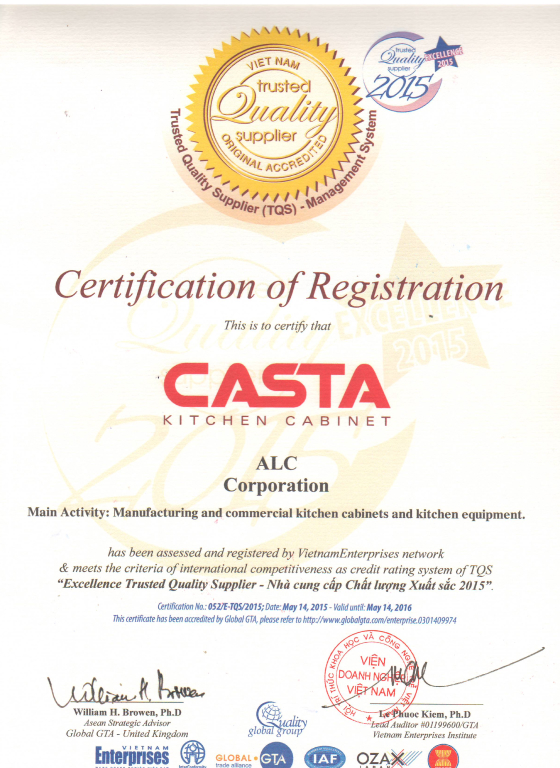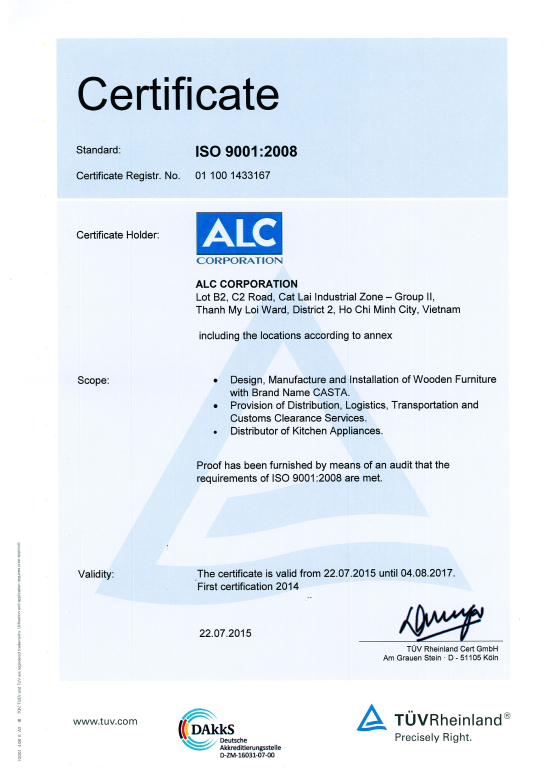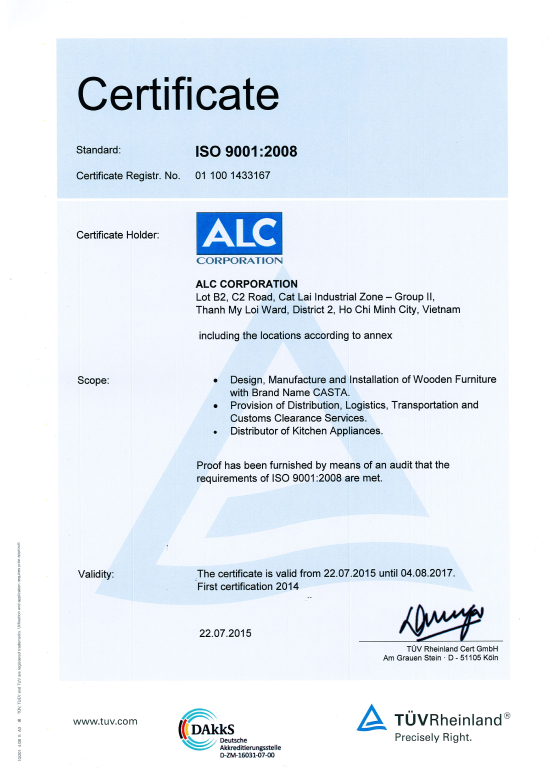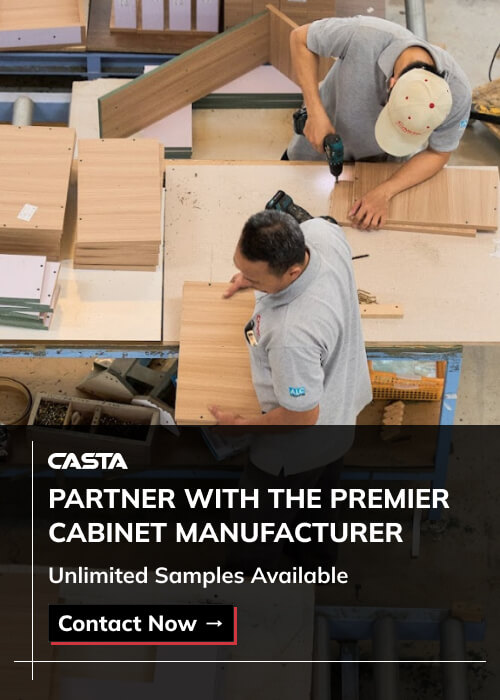Overlay cabinets are a popular and versatile choice in modern cabinetry design, widely used in kitchens, bathrooms, and commercial spaces. But what is overlay cabinets exactly? These cabinets get their name from the way the doors overlay or cover the cabinet frame. Depending on the type of overlay (full or partial), the doors can either entirely or partially cover the cabinet frame, giving a different look and functionality.
The beauty of overlay cabinet lies in their simplicity, cost-effectiveness, and flexibility. For contractors and cabinet brands, overlay cabinet offers a range of design possibilities that cater to various aesthetic preferences and budget constraints. Whether it’s a sleek, modern kitchen or a more traditional space, overlay cabinets can fit seamlessly into almost any design vision.
Overlay cabinet has become increasingly popular in North America due to their ability to provide a clean, uninterrupted look while maximizing storage space. In this guide, we’ll explore the types of overlay cabinet, how to measure and install them, customization options, and the advantages they offer for contractors and cabinet brands.
Table of Content
1. Types of Overlay Cabinets: Full vs. Partial Overlay
Overlay cabinets can be broadly categorized into two types: full overlay and partial overlay. Each type offers its unique aesthetic and functional benefits.
1.1 Full Overlay Cabinet
- Definition: Full overlay cabinets have doors that cover almost the entire cabinet frame, leaving little to no visible frame between doors and drawers. The result is a sleek, streamlined appearance that’s ideal for modern kitchens and bathrooms.
- Ideal for: Full overlay cabinets are perfect for homeowners seeking a minimalist and contemporary design. They are commonly used in modern and transitional kitchen designs, where the focus is on clean lines and a clutter-free aesthetic.
- Data/Analysis: Full overlay cabinets typically require a 1 to 1.25-inch overlay, creating a nearly seamless surface across the cabinetry. This design also maximizes storage space inside the cabinet, as there is no visible frame to interfere with the functionality of drawers and shelves.
- Advantages: Full overlay cabinets offer a modern, high-end look while maximizing storage space. Their continuous surface makes cleaning easier and enhances the overall aesthetic of the room. However, this type of cabinet may require more precision in installation to ensure that the doors and drawers align perfectly.
1.2 Partial Overlay Cabinet
- Definition: Partial overlay cabinets, also known as traditional overlay cabinets, have doors that partially cover the cabinet frame. A portion of the frame remains visible between the doors and drawers.
- Ideal for: Partial overlay cabinets are ideal for traditional or more budget-conscious projects. They offer a more classic appearance, often found in older homes or traditional kitchen designs.
- Data/Analysis: Partial overlay cabinets typically have a 0.5-inch overlay, which means more of the cabinet frame is visible. This reduces the overall cost of the cabinetry, as it requires less precision in door alignment compared to full overlay cabinets.
- Advantages: Partial overlay cabinets offer a traditional aesthetic and are often more affordable than full overlay designs. They are easier to install and provide a distinct, framed look that can complement rustic or traditional kitchen styles.
Learn more: Inset vs Overlay Cabinets: Key Differences, Costs, and Which to Choose
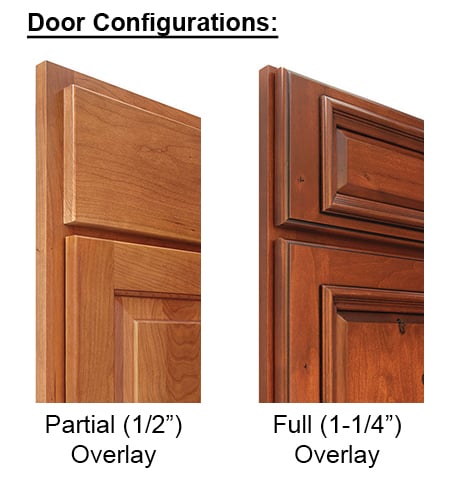
1.3 Comparison Table: Full vs. Partial Overlay Cabinets
| Cabinet Type | Full Overlay Cabinet | Partial Overlay Cabinet |
| Design | Sleek, modern, minimal gaps | Traditional, visible frame |
| Cost | Higher due to precision in design | More budget-friendly, lower cost |
| Storage Space | Maximized, minimal frame intrusion | Less storage space, frame takes up space |
| Aesthetic | Seamless, continuous surface | Traditional, framed look |
| Installation | Requires more precise alignment | Easier to install |
| Customization | High level of customization available | Limited customization compared to full overlay |
2. How to Measure Cabinet Hinge Overlay: Step-by-Step Guide
Getting the correct measurements for cabinet hinge overlay is essential for a successful cabinet installation. Measuring the hinge overlay ensures that the cabinet doors fit perfectly and function properly.
2.1 Step-by-Step Guide to Measuring Hinge Overlay:
- Measure the Cabinet Opening: Start by measuring the width and height of the cabinet opening (the inside area of the cabinet where the door will sit). This is the most critical measurement, as it determines how much of the door will cover the cabinet frame.
- Measure the Door: Next, measure the width and height of the door itself. This will help you calculate the overlay.
- Calculate the Overlay: Subtract the width of the cabinet opening from the width of the door. The difference is the overlay measurement, or how much of the door will cover the frame. Repeat this process for both the width and height of the door.
- Confirm Hinge Compatibility: Once you have the overlay measurement, ensure that the hinges you plan to use are compatible with the overlay size. This is particularly important for full overlay cabinets, where precise alignment is critical.
2.2 Tools Needed:
- Measuring tape or ruler
- Hinge template or jig (optional)
- Pencil and paper for recording measurements
Incorrect measurements can lead to improper door alignment, which can cause installation delays and additional costs. Properly measuring the overlay will help contractors avoid these issues and ensure that the doors and hinges fit perfectly on the first try.
3. How to Install Overlay Cabinet Hinges: Installation Tips for Contractors
Installing overlay cabinet hinges requires attention to detail to ensure that the doors align correctly with the cabinet frame. Whether working with full overlay or partial overlay cabinets, proper installation is key to achieving a polished and functional result.
3.1 Step-by-Step Installation Guide:
- Position the Hinges: Align the hinges on the cabinet door, making sure they are evenly spaced. Most hinges should be positioned about 3-4 inches from the top and bottom edges of the door.
- Mark the Hinge Locations: Use a pencil to mark the hinge locations on both the cabinet door and the cabinet frame.
- Drill Pilot Holes: Using a power drill, create pilot holes where the hinge screws will be inserted. Pilot holes help prevent the wood from splitting and ensure accurate hinge placement.
- Attach the Hinges to the Door: Secure the hinges to the door first, making sure they are aligned properly. Be careful not to overtighten the screws, as this could misalign the door.
- Mount the Door to the Cabinet Frame: Align the hinges with the marks on the cabinet frame and attach the door. Adjust the door as needed to ensure proper alignment and smooth operation.
3.2 Tools Needed for Installation:
- Power drill
- Hinge screws
- Measuring tape
- Clamps (optional for holding the door in place during installation)
Proper installation of overlay cabinet hinges typically takes less time than inset hinges, as the doors do not need to be precisely flush with the cabinet frame. This can save contractors 10-15% of installation time, making overlay cabinets a more efficient option for large-scale projects.
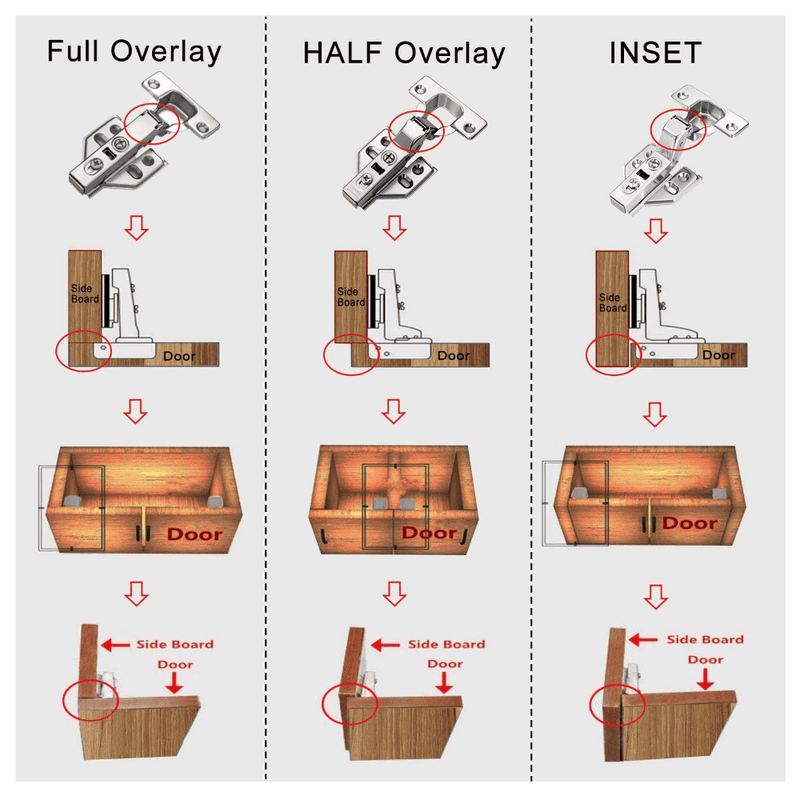
4. Customizing Overlay Cabinets for Specific Projects: Tailoring to Client Needs
Customization is one of the most attractive features of overlay cabinet, especially when working on high-end residential or commercial projects. Contractors and cabinet brands can tailor overlay cabinets to fit the unique needs of each client, ensuring that the final product matches both the functional requirements and aesthetic preferences of the project.
4.1 Key Areas for Customization:
- Finishes: Choose from a wide range of finishes, including paint, stain, or gloss. Customizing the finish allows the cabinets to blend seamlessly with the rest of the room’s design.
- Materials: Select between solid wood for durability and luxury or MDF for a cost-effective yet stylish solution. Each material offers different levels of durability and cost, allowing for a wide range of design possibilities.
- Hardware: Choose between concealed hinges for a more modern look or exposed hinges for a traditional aesthetic. Additionally, customize the handles and knobs to match the overall design.
Learn more: Cabinet Hardware Size Guide
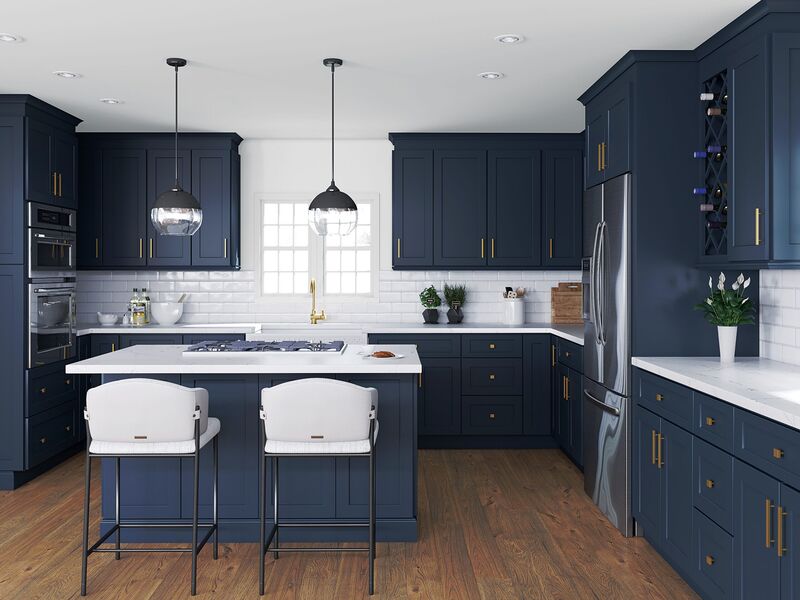
4.2 Case Study: Customizing Overlay Cabinets for a High-End Kitchen Renovation
In a recent high-end kitchen renovation, the client wanted a modern look with sleek, full overlay cabinet. The contractor worked with Casta Cabinetry to customize the cabinet design, choosing a matte white finish and sleek, concealed hinges. The result was a minimalist kitchen with clean lines and ample storage space, perfectly suited to the client’s aesthetic preferences.
By offering customization options, contractors can ensure that the final product meets the specific needs and tastes of the client, enhancing both functionality and satisfaction.
Learn more: Kitchen cabinets direct from manufacturer
5. Comparing Overlay Cabinets with Other Cabinet Types: Inset, Frameless, Etc.
Overlay cabinets offer a unique combination of functionality and aesthetics, but how do they compare to other popular cabinet types like inset and frameless cabinets?
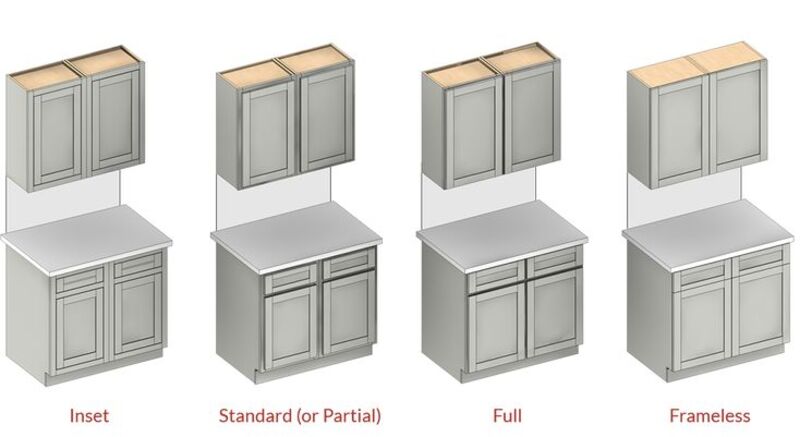
5.1 Inset Cabinets:
- Design: Inset cabinets have doors that sit inside the cabinet frame, creating a flush surface. This design offers a classic, traditional look but requires more precision in installation.
- Cost: Inset cabinets are typically more expensive than overlay cabinet due to the craftsmanship required to create a flush fit.
- Installation: Installing inset cabinets is more complex and time-consuming than overlay cabinets, as the doors must align perfectly within the frame.
- Customization: Inset cabinets offer moderate customization options, but the flush design limits the variety of finishes and hardware choices.
Learn more: Inset vs Overlay Cabinets - Ultimate Guide for Smart Choices
5.2 Frameless Cabinets:
- Design: Frameless cabinets, also known as European-style cabinets, have doors that attach directly to the cabinet box without a front frame. This design maximizes storage space and offers a sleek, modern look.
- Cost: Frameless cabinets are generally comparable in cost to full overlay cabinets, but the lack of a frame can make them more affordable depending on the materials used.
- Installation: Frameless cabinets are easier to install than inset cabinets, but they may require more precision than overlay cabinets due to the lack of a frame for support.
- Customization: Frameless cabinets offer limited customization options, but they are ideal for minimalist designs where storage space is a priority.
5.3 Comparison Table: Overlay Cabinet vs. Other Cabinet Types
| Cabinet Style | Overlay Cabinets | Inset Cabinets | Frameless Cabinets |
| Design | Clean, modern, flexible | Classic, traditional, flush | Minimalist, full access |
| Cost | Moderate | Higher due to precision | Similar to overlay, sometimes more affordable |
| Installation | Easier, less time-consuming | More complex, requires precision | Easier than inset but requires precision |
| Customization | High level of customization available | Moderate customization options | Limited customization |
| Storage Space | Maximized due to minimal frame intrusion | Less storage space due to frame | Maximized, no frame to interfere |
Learn more: Framed vs Frameless Cabinets: Which one is better for contractors?
6. Cost and Time Analysis: How Much Overlay for Cabinet Doors?
The cost and time required to install overlay cabinets depend on several factors, including the type of overlay (full or partial), the materials used, and the complexity of the installation process.
6.1 Cost Analysis:
- Material Costs: The cost of overlay cabinet varies depending on the materials used. Solid wood cabinets are typically 30% more expensive than MDF or particleboard options. However, they offer superior durability and a more premium aesthetic.
- Full vs. Partial Overlay: Full overlay cabinets tend to be 10-20% more expensive than partial overlay cabinets due to the need for precision in door alignment and hardware installation.
- Labor Costs: Full overlay cabinet may require more time and attention to detail during installation, which can increase labor costs. Partial overlay cabinets are easier to install and may result in lower overall installation costs.
Learn more: Cost of Custom Cabinetry
6.2 Time Analysis:
- Installation Time: Full overlay cabinets typically take 10-15% longer to install than partial overlay cabinets due to the need for precise door alignment. However, the difference in time is relatively small, and advances in production and installation techniques can help reduce this time.
- Project Timelines: Contractors and cabinet brands should factor in the additional time required for full overlay cabinet installations when planning project timelines, especially for large-scale commercial or residential projects.
Learn more: Understanding lead times and supply chain resilience in Vietnam
7. Casta Cabinetry: Your Trusted Partner for High-Quality Overlay Cabinets
Casta Cabinetry is a leading provider of overlay cabinets, offering contractors and cabinet brands high-quality, customizable solutions for residential and commercial projects. With a state-of-the-art manufacturing facility in Vietnam that utilizes European machinery, Casta Cabinetry delivers precision-crafted cabinets that meet the highest industry standards.
Why Choose Casta Cabinetry?
- Customization: Casta Cabinetry offers a wide range of customization options, including finishes, materials, and hardware, allowing clients to tailor their cabinets to fit specific design needs.
- Sustainability: All of Casta’s cabinets are made with FSC-certified wood and low-VOC finishes, ensuring that the products are environmentally friendly and safe for indoor use.
- Health-Conscious Materials: Casta Cabinetry is committed to using health-conscious materials that comply with CARB standards, ensuring that their products contribute to healthier indoor air quality.
- Delivery and Support: With comprehensive delivery and installation support, Casta Cabinetry ensures that projects are completed on time and to the highest standards.
By choosing Casta Cabinetry, contractors and cabinet brands gain access to top-quality overlay cabinets that combine style, functionality, and sustainability.
Learn more: Industrial Cabinet Manufacturers
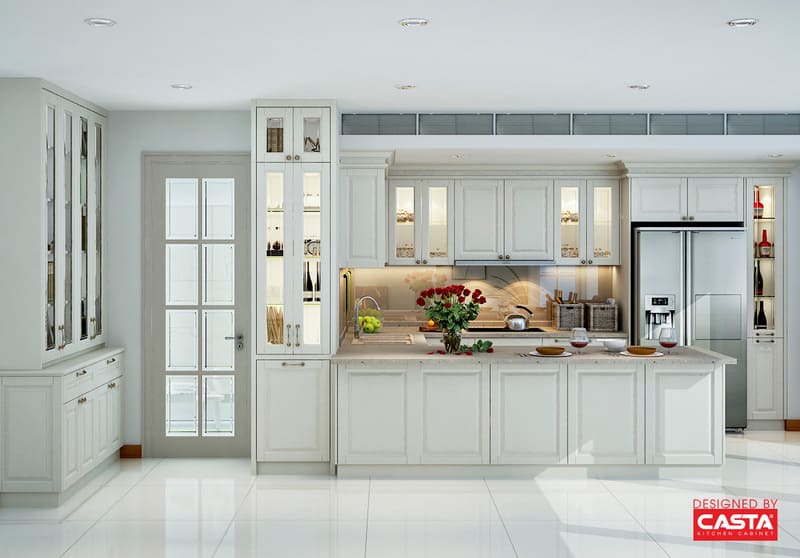
8. Why Should You Choose Overlay Cabinets for Modern Projects
Overlay cabinets offer numerous advantages for contractors and cabinet brands working on modern projects. From their sleek, contemporary design to their ease of installation, overlay cabinets provide a practical and visually appealing solution for a wide range of residential and commercial spaces.
8.1 Performance and Durability:
Overlay cabinets are designed to be durable and long-lasting. The tight door fittings and minimal gaps between doors reduce the risk of warping or damage over time, making them a reliable choice for high-traffic areas like kitchens and bathrooms.
Industry data shows that the demand for overlay cabinets has increased by 25% in the last five years, particularly in commercial and high-end residential projects. This growing popularity is a testament to their versatility and appeal.
8.2 Flexibility in Design:
The ability to customize overlay cabinets with different finishes, materials, and hardware makes them a highly flexible option for contractors and cabinet brands. This flexibility allows for greater creativity in design and ensures that the cabinets can meet the specific needs of each project.
For contractors and cabinet brands looking to deliver both style and functionality, overlay cabinets are a smart investment.
9. FAQ
How to measure cabinet hinge overlay?
How do overlay cabinets compare to inset cabinets in terms of cost?
Can I customize the finish and material of overlay cabinets?
Overlay cabinets offer a unique combination of cost-effectiveness, design flexibility, and ease of installation, making them a valuable addition to any project. Whether you choose full or partial overlay cabinets, the benefits of these cabinets extend beyond aesthetics. Their durability, customization options, and modern appeal make them a worthwhile investment for both residential and commercial projects.
For contractors and cabinet brands, partnering with Casta Cabinetry ensures access to high-quality, customizable overlay cabinets that meet the highest standards of craftsmanship and sustainability. By choosing overlay cabinets, you can enhance the functionality and visual appeal of your projects while providing clients with a product that offers long-lasting value.
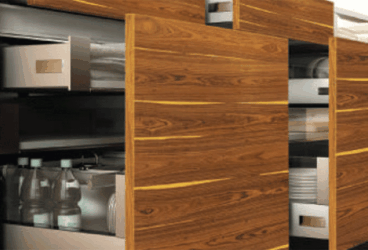
MDF vs Plywood for Kitchen Cabinets – Which is Better?...
MDF vs Plywood for kitchen cabinets is one of the most important decisions contractors and furniture brands must make wh...
11/14/2025 | David Nguyen
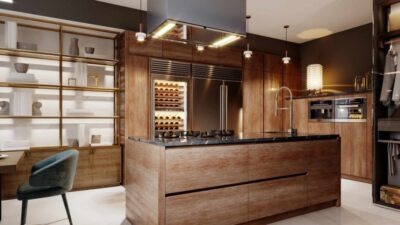
Plywood Kitchen Cabinets: Pros and Cons Explained for Contra...
Plywood kitchen cabinets are now one of the most preferred options in modern kitchen manufacturing, combining durability...
11/12/2025 | David Nguyen
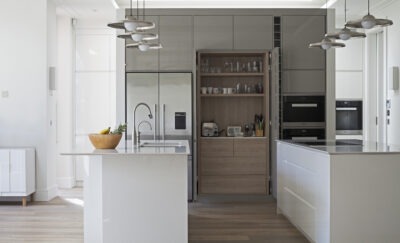
Best Italian Kitchen Cabinets: Modern Design, Precision Craf...
Italian kitchen cabinets represent the gold standard in modern kitchen design — celebrated for their craftsmanship, slee...
10/29/2025 | David Nguyen
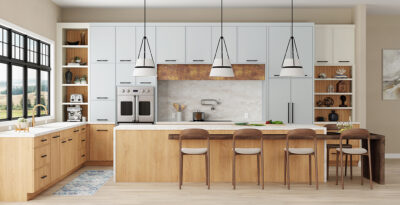
European vs American Kitchen Cabinets: Key Differences &...
European vs American kitchen cabinets is a core decision for anyone specifying cabinetry for modern buildings or homes. ...
10/27/2025 | David Nguyen
Contact us
Casta is always ready to listen and answer all customers' questions
